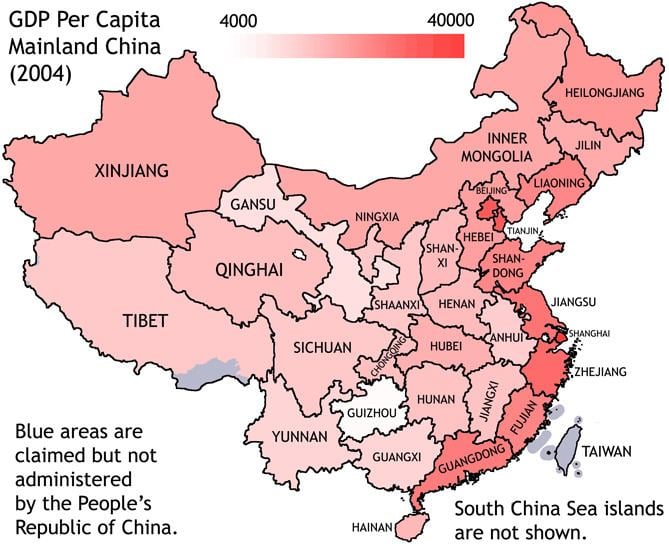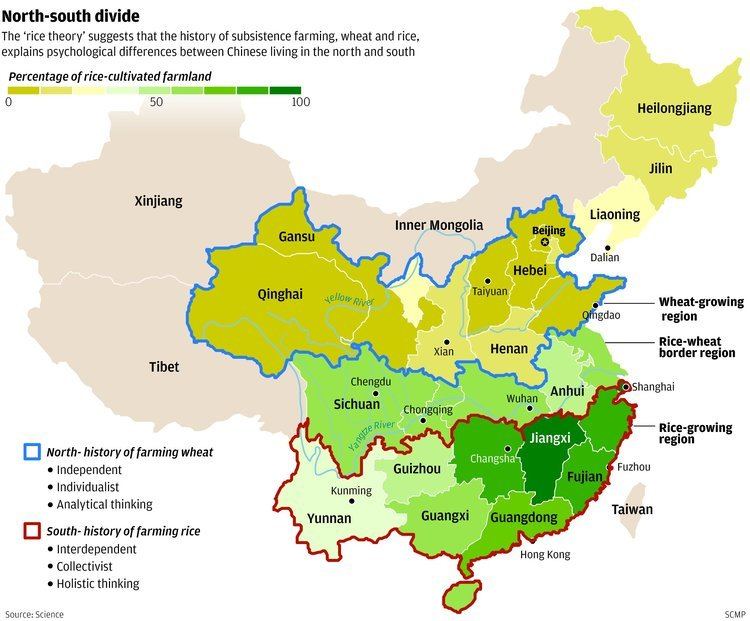 | ||
Differences between northern and southern china
Northern China and southern China are two approximate regions within China. The exact boundary between these two regions are not precisely defined. Nevertheless, the self-perception of Chinese people, especially regional stereotypes, has often been dominated by these two concepts, given that regional differences in culture and language have historically fostered strong regional identities (simplified Chinese: 乡土; traditional Chinese: 鄉土; pinyin: xiāngtǔ) of the Chinese people.
Contents
- Differences between northern and southern china
- Extent
- History
- Today
- Stereotypes and differences
- References

Extent

Often used as the geographical dividing line between northern and southern China is the Huai River–Qin Mountains Line. This line approximates the 0 °C January isotherm and the 800 millimetres (31 in) isohyet in China.

Culturally, however, the division is more ambiguous. In the eastern provinces like Jiangsu and Anhui, the Yangtze River may instead be perceived as the north–south boundary instead of the Huai River, but this is a recent development.

There is an ambiguous area, the region around Nanyang, Henan, that lies in the gap where the Qin has ended and the Huai River has not yet begun; in addition, central Anhui and Jiangsu lie south of the Huai River but north of the Yangtze, making their classification somewhat ambiguous as well. As such, the boundary between northern and southern China does not follow provincial boundaries; it cuts through Shaanxi, Henan, Anhui, and Jiangsu, and creates areas such as Hanzhong (Shaanxi), Xinyang (Henan), Huaibei (Anhui) and Xuzhou (Jiangsu) that lie on an opposite half of China from the rest of their respective provinces. This may have been deliberate; the Mongol Yuan dynasty and Han Chinese Ming dynasty established many of these boundaries intentionally to discourage regionalist separatism.

The Northeast (Manchuria) and Inner Mongolia, areas that are often thought of as being outside "China proper", are also conceived to belong to northern China according to the framework above. Historically, Xinjiang, Tibet and Qinghai were not usually conceived of as being part of either the north or south. However, Xinjiang is now regarded as being part of the north due to the spread of north Chinese culture and the use of Mandarin.
History

The concepts of northern and southern China originate from differences in climate, geography, culture, and physical traits; as well as several periods of actual political division in history. Northern China is too cold and dry for rice cultivation (though rice is grown there today with the aid of modern technology) and consists largely of flat plains, grasslands, and desert; while Southern China is warm and rainy enough for rice and consists of lush mountains cut by river valleys. Historically, these differences have led to differences in warfare during the pre-modern era, as cavalry could easily dominate the northern plains but encountered difficulties against river navies fielded in the south. There are also major differences in language, cuisine, culture, and popular entertainment forms.
Episodes of division into North and South include:
The Northern and Southern Dynasties showed such a high level of polarization between North and South that northerners and southerners referred to each other as barbarians; the Mongol Yuan dynasty also made use of the concept: Yuan subjects were divided into four castes, with northern Han Chinese occupying the third-caste and southern Han Chinese occupying the lowest one.
For a large part of Chinese history, northern China was economically more advanced than southern China. The Jurchen and Mongol invasion caused a massive migration to southern China, and the Emperor shifted the Song Dynasty capital city from Kaifeng in northern China to Hangzhou, located south of the Yangtze river. The population of Shanghai increased from 12,000 households to over 250,000 inhabitants after Kaifeng was sacked by invading armies. This began a shift of political, economic and cultural power from northern China to southern China. The east coast of southern China remained a leading economic and cultural center of China until the Republic of China. Today, southern China remains economically more prosperous than northern China.
During the Qing dynasty, regional differences and identification in China fostered the growth of regional stereotypes. Such stereotypes often appeared in historic chronicles and gazetteers and were based on geographic circumstances, historical and literary associations (e.g. people from Shandong, were considered upright and honest) and Chinese cosmology (as the south was associated with the fire element, Southerners were considered hot-tempered). These differences were reflected in Qing dynasty policies, such as the prohibition on local officials to serve their home areas, as well as conduct of personal and commercial relations. In 1730, the Kangxi Emperor made the observation in the Tingxun Geyan (《庭訓格言》):
The people of the North are strong; they must not copy the fancy diets of the Southerners, who are physically frail, live in a different environment, and have different stomachs and bowels.
During the Republican period, Lu Xun, a major Chinese writer, wrote:
According to my observation, Northerners are sincere and honest; Southerners are skilled and quick-minded. These are their respective virtues. Yet sincerity and honesty lead to stupidity, whereas skillfulness and quick-mindedness lead to duplicity.
Today
In modern times, North and South is merely one of the ways that Chinese people identify themselves, and the divide between northern and southern China has been complicated both by a unified Chinese nationalism and as well as by local loyalties to province, county and village which prevent a coherent Northern or Southern identity from forming.
During the Deng Xiaoping reforms of the 1980s, South China developed much more quickly than North China leading some scholars to wonder whether the economic fault line would create political tension between north and south. Some of this was based on the idea that there would be conflict between the bureaucratic north and the commercial south. This has not occurred to the degree feared in part because the economic fault lines eventually created divisions between coastal China and the interior, as well as urban and rural China, which run in different directions from the north–south division, and in part because neither north or south has any type of obvious advantage within the Chinese central government. In addition there are other cultural divisions that exist within and across the north–south dichotomy.
Stereotypes and differences
Nevertheless, the concepts of North and South continue to play an important role in regional stereotypes.
"Northerners" are seen as:
while "Southerners" are seen as:
It should be noted that these are only rough and approximate stereotypes among a large and greatly varied population.
